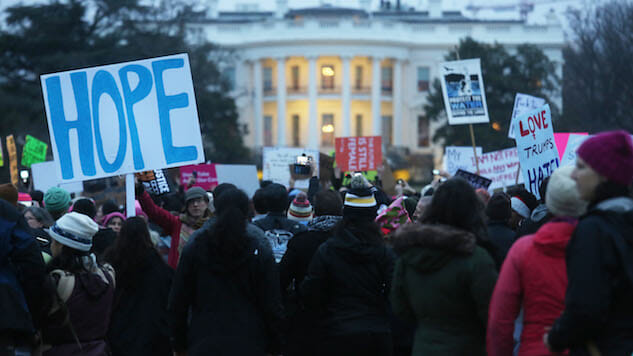Thirteen Years On, Rebecca Solnit’s Hope in the Dark Offers a Vision for Defiance, Not Despair, in the Age of Trump
Photos by Mario Tama/Getty Images
On Friday, a man who has lied, cheated, insulted, threatened and groped his way through life was sworn in as President of the United States of America. After nearly two years of a farcical and corroding electoral process that revealed little more than a dark, powerful sense of alienation and resentment, it was finally done. No more speculative pieces about how this institution or that would step in where the others had failed; no more reassuring platitudes about how the office would tame the man. The moment well over half the voting population has been dreading, the moment few—including, perhaps, the man himself—had thought possible, has finally arrived. Donald Trump, a former reality TV star and a businessman of ill repute, is now the President.
On Saturday, millions gathered in cities across the U.S. and the world to voice their anger, frustration and fear at the fact that that man—a model of ignorance, misogyny and utter narcissism—was being handed the levers of utmost power. More than a few protesters’ signs reflected disbelief. “Wtf?” “I Can’t Believe This Shit.” “Meh. Ugh. Omfg.” And, my personal favorite: “We F#cked Up Bigly.” But there was another feeling in the air on Saturday when I joined an enormous crowd in the Women’s March on Washington: hope. It was a tenuous feeling—a far cry from the waves of emotion that surged through Washington eight years ago—and contingent, too. Yet there it was, best exemplified, in my opinion, in the following two chants:
“We will not go away / welcome to your first day!”
“Donald, escucha / estamos en la lucha!”
![]()
“Sometime before the election was over,” Rebecca Solnit writes in her slim 2004 treatise Hope in the Dark, “I vowed to keep away from what I thought of as ‘the Conversation,’ the tailspin of mutual wailing about how bad everything was, a recitation of the evidence against us—one exciting opportunity the left offers is of being your own prosecutor—that just buried any hope and imagination down into a dank little foxhole of curled-up despair.”
Solnit wrote this paragraph after the election that handed George W. Bush a second term in office despite massive opposition from leftists, liberals and progressives of all stripes. The re-election of a man who had proven to be as foolish as he had seemed, who had led the country into an illegitimate war that had already become the quagmire it remains today, was a devastating blow to those who couldn’t imagine that Americans would make the same mistake twice.
It’s a curious paragraph to read in the aftermath of the election of Trump, whose candidacy and election was opposed not only by progressives, but by many Bush-era conservative technocrats and mainstream Republicans alike. Trump’s election has certainly unleashed millions of “Conversations”—raise your hand if that’s you—and with good reason: he has threatened to deport millions of immigrants, command the armed forces to use torture and revoke healthcare for 20 million Americans—all while stoking an ethnocentric, rage-filled rhetoric and praising autocrats around the globe. His actions, meanwhile, offer little comfort: he has appointed a loan shark to lead the Treasury department, an heiress completely ignorant of education policy to lead the Education Department, a surgeon whose spokesperson had previously declared him incapable of running a governmental agency to Housing and Urban Development, and a man previously deemed too racist to be a federal judge to Attorney General. Not only that, but the election gave us a brutal demonstration in how fragmented and top-heavy the Democratic Party really is—an easy phenomenon to overlook during Obama’s eight years in office.
-

-

-

-

-

-

-

-

-

-

-

-

-

-

-

-

-

-

-

-

-

-

-

-

-

-

-

-

-

-

-

-

-

-

-

-

-

-

-

-








































